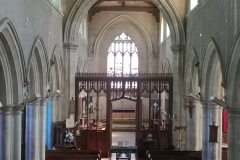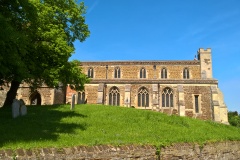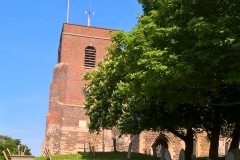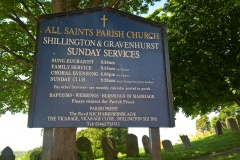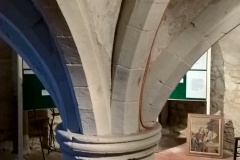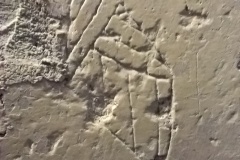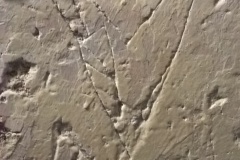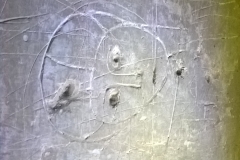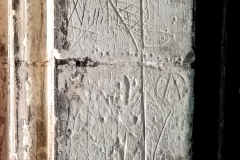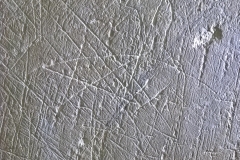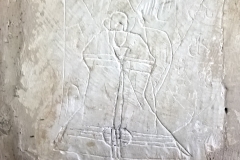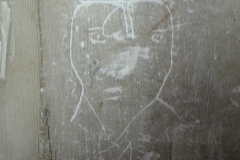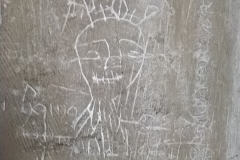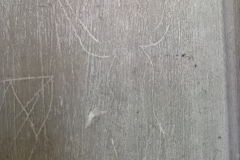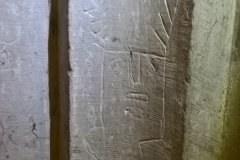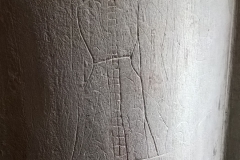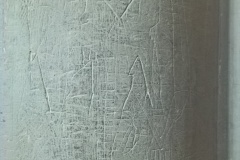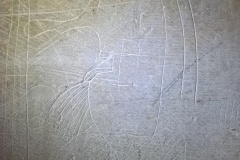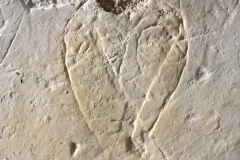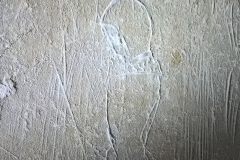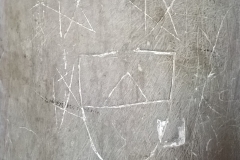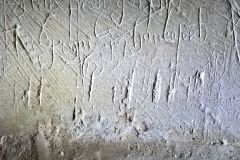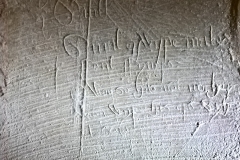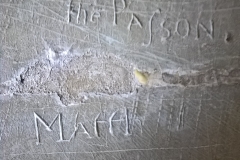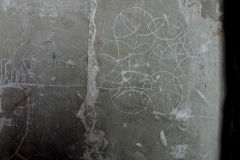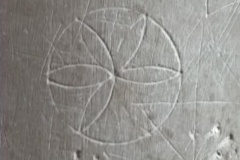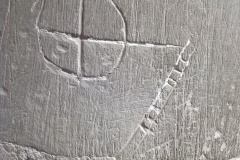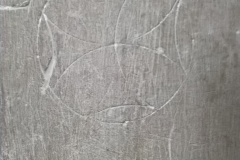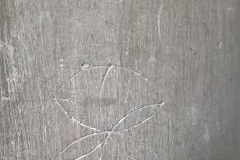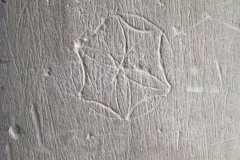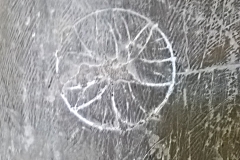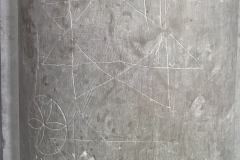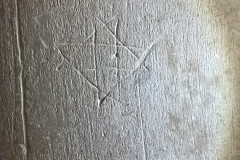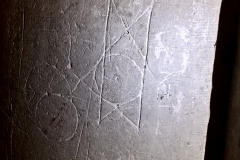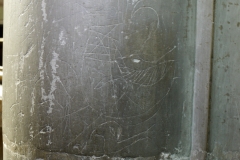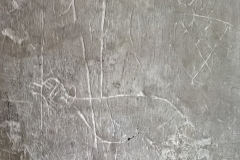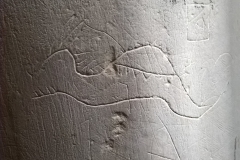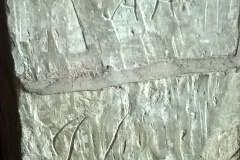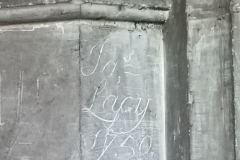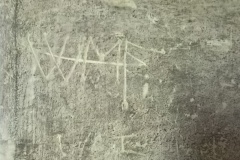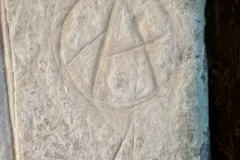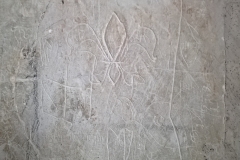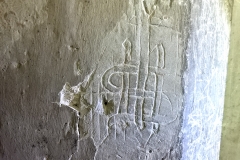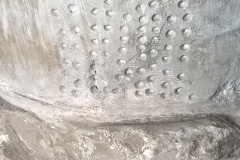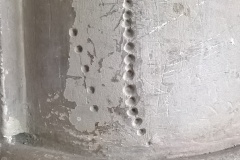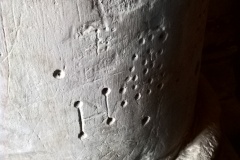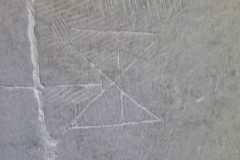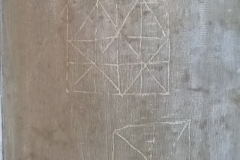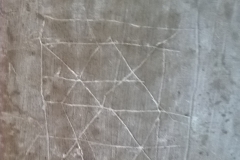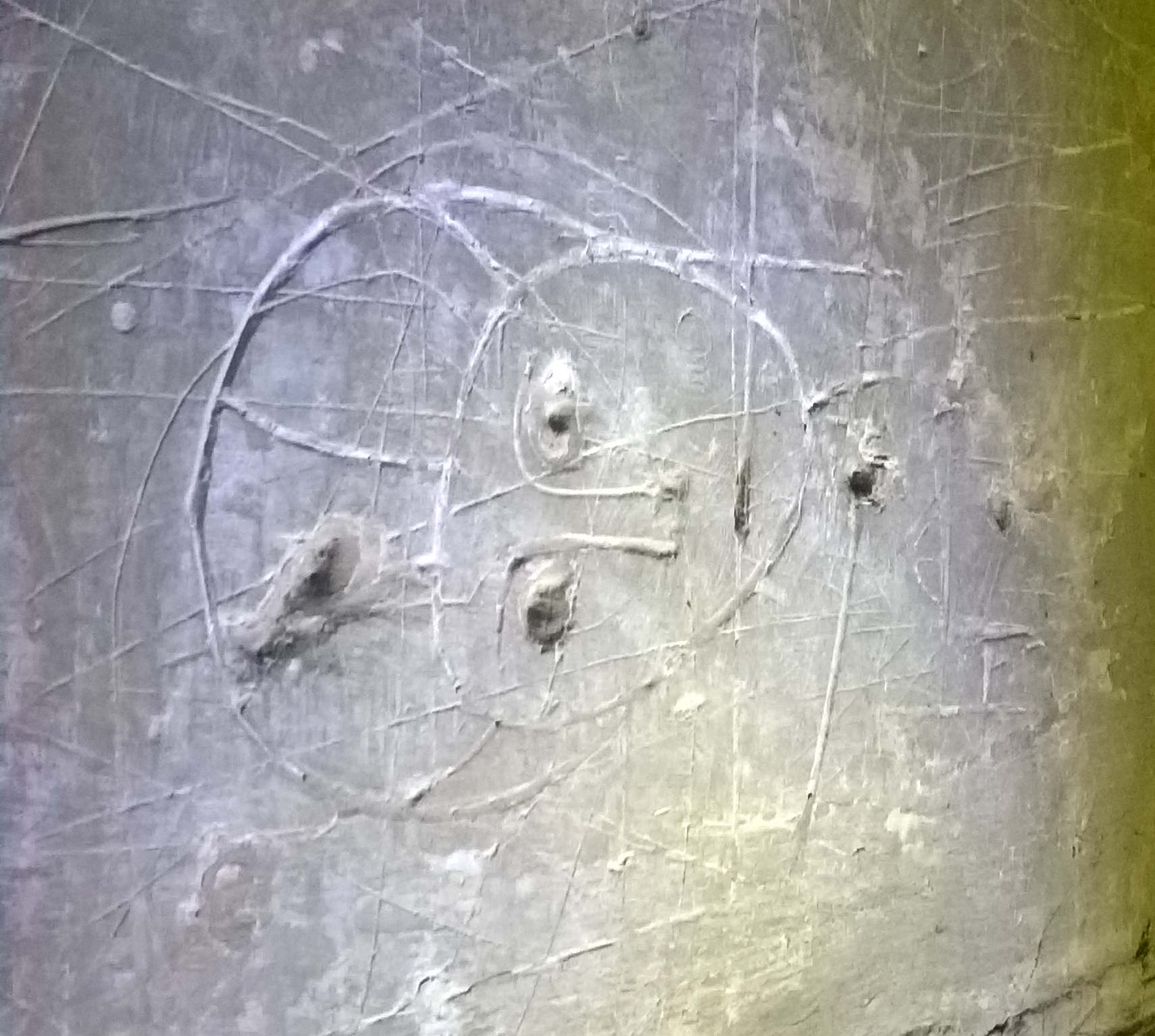
All Saints’ Church in Shillington occupies a commanding position on a hill with excellent views of the surrounding countryside. This was my first Bedfordshire church on a trip where I set out to follow in the footsteps of Violet Pritchard, one of the pioneers in the field of English medieval graffiti.
Talking a campervan up the narrow lane leading to the church was a somewhat nerve racking experience, but fortunately the lane widened out into a parking area large enough for several cars plus our van, but with mourners gathering for a funeral, we took advantage of a sunny day to go for a walk while the service was on. Once the funeral party had dispersed, we went up to the church and received a warm welcome from the Reverend Richard Winslade who was well acquainted with many of the church’s graffiti treasurers. He showed us around, including the crypt, then left us to our own devices to hunt for the figures recorded in Violet Pritchard’s book English Medieval Graffiti and take photographs.
The church is a Grade 1 listed building. According to Pritchard, the construction appears to have started at the east end around 1300, however most of the current structure appears to date to the 14th century, with only the tower having been rebuilt in modern times. The church is built of coursed ironstone and the interior is light and airy, with the nave soaring to an impressive height of 70 feet, which is high for its period.
All Saints’ is unusual in having an open crypt, and by following the signs and pressing the relevant light switches, as indicated, this can be visited. Pritchard quotes Dr W Moore Ede, Dean of Worcester (1908 – 1934) who stated that ‘crypts were rarely, if ever’ built after the end of the 12th century’ and so this is taken as evidence of an earlier church on the site.
With a little searching, we were able to identify all the major graffiti illustrated by Pritchard. Her figures were obtained by rubbings and she then often simplified the drawings from there, only including what she considered to be the main relevant lines for each figure, as there are frequently many other lines built up into a palimpsest, often difficult to ‘read’. The first figure she talks about (her fig. 13) is the head of a woman, situated as she describes in the tower. This is a woman’s head with a surrounding halo, which Pritchard believed dates to the 12th century. Her illustration shows the head in an upright position, whereas in fact the block is on its side, as shown above. Pritchard believed the head might have been part of a large wall-painting in an earlier building and the block had been reused in the building of the tower. What I don’t understand, however, is Pritchard’s reference to the ‘cross on the halo’, which she says is ‘an important details of the drawing as it can be dated fairly accurately by its design.’ I’ve been unable to identify the cross in either her illustration or the photograph.
Her second figure is that of a hobby horse found on the left hand side of the south door to the church, inside the porch. Pritchard was puzzled by this figure until other examples were found in Girton, Cambridgeshire and Wallington, Hertfordshire. The drawing spans more than one block, indicating that it was drawn in situ. Pritchard ascribes a date soon after 1300 to this figure. The next drawing is the small head of a man situated next to a pentagram, which helped us to find the right figure. Pritchard quoted Sir James Mann who described the figure as follows: ‘… a bearded man in a bascinet with mail aventail.’ This figure is on a pillar on the south side of the nave at its eastern end. The next figure, on the rear of the same pillar, is a bell. Pritchard dates this to the 14th century, but mentions the possibility of it being 16th century if it was intended to be the type of bell that is held in a fixed position and rung by means of the being swung to it, rather than the bell itself being rung.
Pritchard also mentions an array of other marks: ‘several small drawing of the Crucifixion on a pillar in the south arcade of the chancel … also there are shields, crests, crowns, crowned heads, funny faces, English verses and Latin inscriptions.’
On the crucifixion scene shown below, the crucified figure is indistinct, but the nail holes in the hands can be seen clearly.
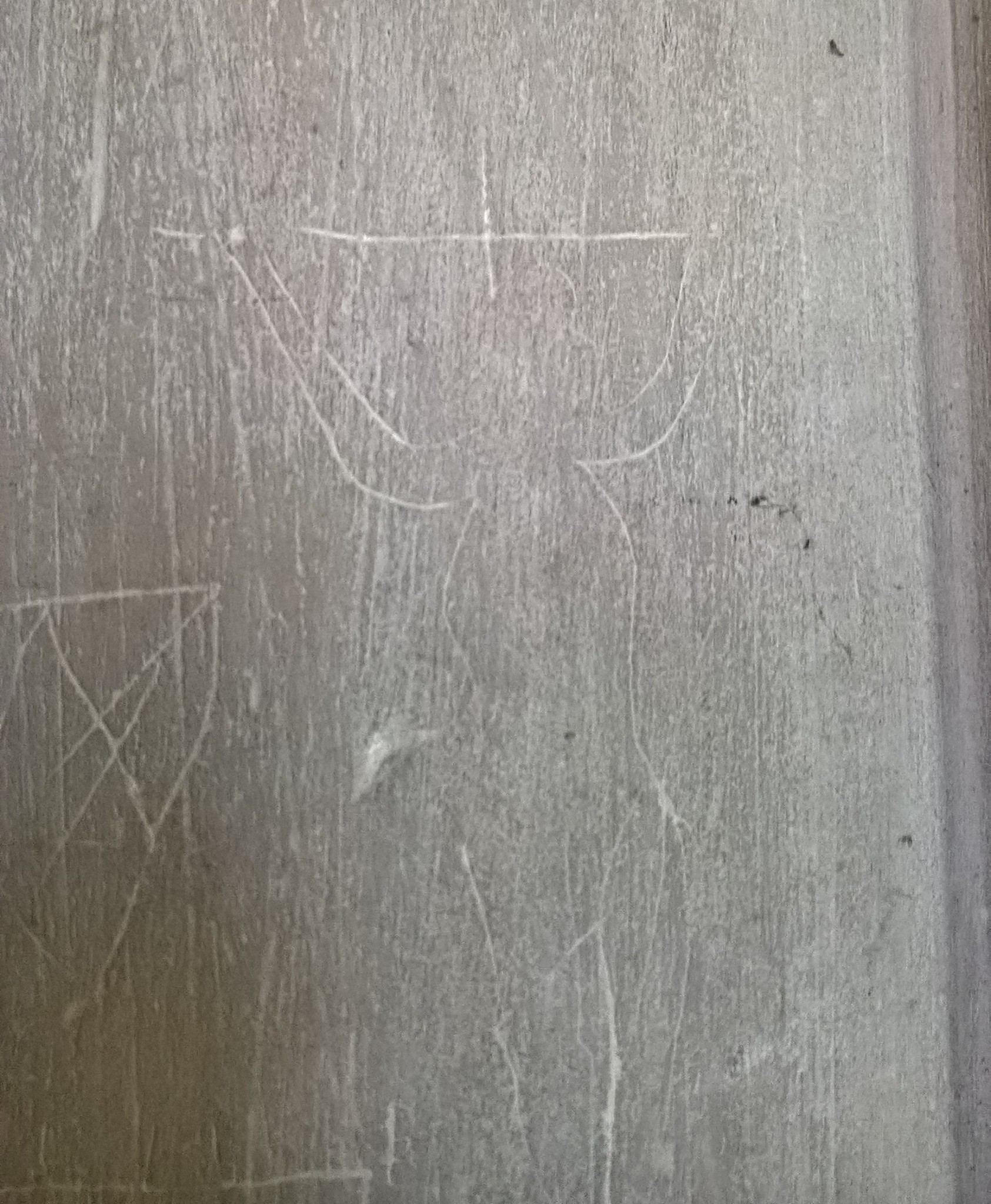
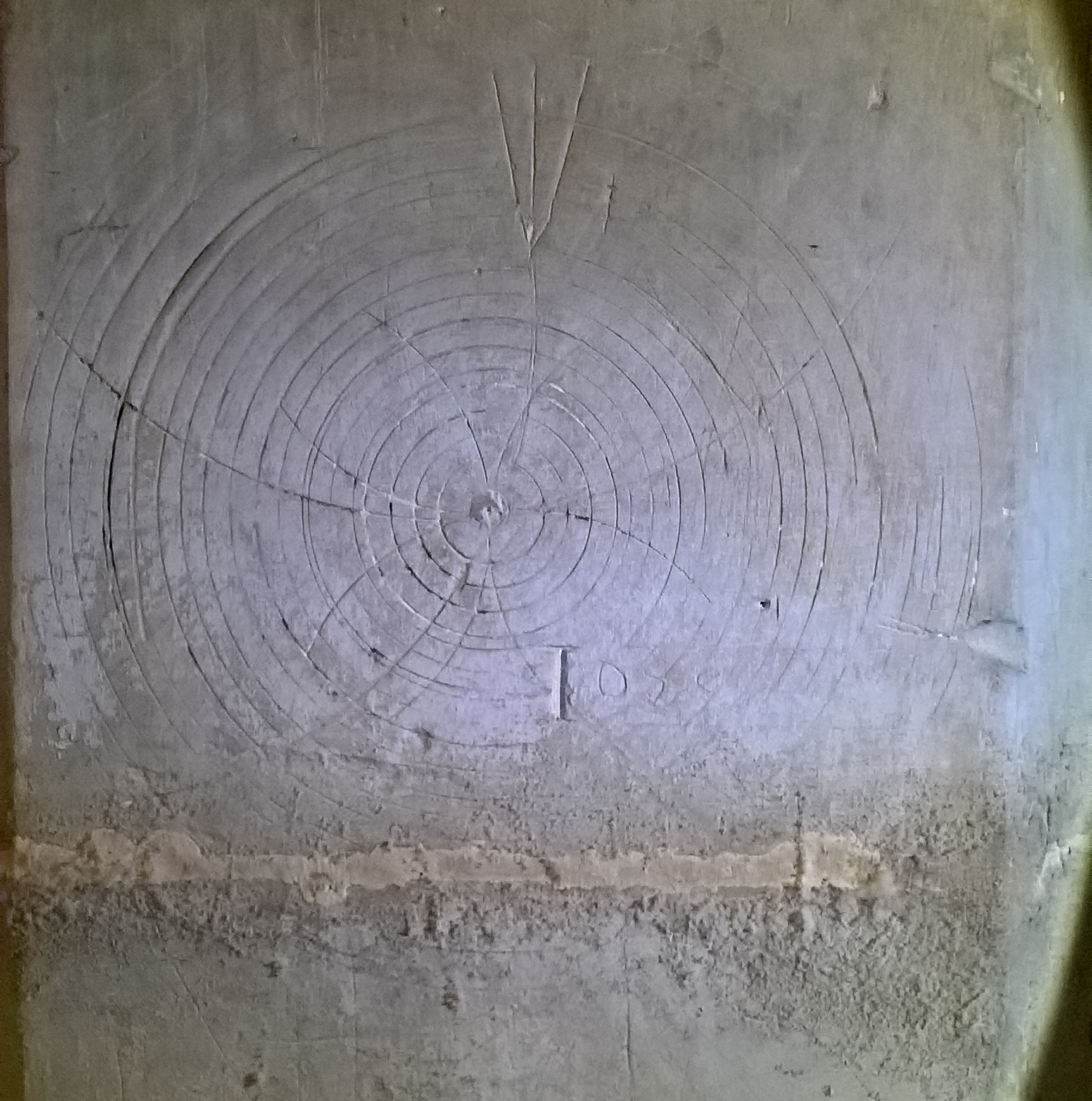
As ever, Pritchard is selective in what she chooses to feature in her book, and I think it’s fair to say that in general she was uninterested in circles or daisy wheels of any kind unless they are in such close proximity to one of her other figures as to be almost impossible to ignore. Shillington contains numerous fine examples of compass-drawn circles and daisy wheels, with one in particular standing out, a large series of concentric circles with the petals of a daisy wheel drawn within the circles, as shown above. Not all the compass-drawn circles found in the church are of such fine workmanship, and some appear to be the result of a bad hair day on the part of their maker.
The various examples of the auseklis cross in the church do not feature in the book, either.
There are also some drawings of animals. The large bird, shown here with a smaller one, if particularly fine, albeit somewhat difficult to decipher on first sight.
All Saints’ also contains the usual array of initials and miscellaneous images, including dot patterns and some merels. The latter are all on upright surfaces, not horizontal.
Report by Linda Wilson
50 Church St,
Shillington,
Hitchin
SG5 3LH
There is parking at the end of Church Street next to the church. The church is open during daylight hours.
Note: Due to inadequate torchlight (I left my best torches at home by accident, along with my scale barst), the brightness and contrast have been altered on some of the images shown above, but no other enhancement has taken place.
Search terms: woman’s head, head, pentagram, bell, worm, crypt, hobby horse, bearded man, human figures, crucifixion. crowned head, script, latin script, shield, merel, concentric circles, daisy wheel (Incomplete) daisy wheel, aukselis cross, bird, birds, dog, initials, 1750, fleur de lys, IHN, christogram, dot pattern.

